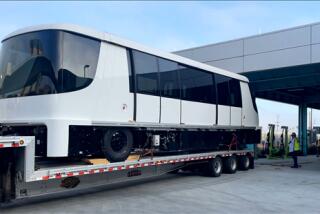Shanghai Rising With a Bullet
- Share via
SHANGHAI — The world’s fastest train, which literally flies a fraction of an inch above the tracks at 250 mph, made its maiden voyage here Tuesday in China’s most futuristic city.
Chinese Premier Zhu Rongji and German Chancellor Gerhard Schroeder braved the morning chill on the last day of 2002 to test out the magnetic levitation train, or maglev.
The $1.2-billion Sino-German venture is another trophy project for trendsetting Shanghai. Last month, the city won the right to host the 2010 World Exposition and inked a deal with Universal Parks & Resorts for a major amusement park.
As the world’s first city to operate the maglev as a passenger train, Shanghai took another step in its campaign to become a world-class metropolis and high-technology hub.
“China is a fast-growing economy -- it requires a fast form of transportation,” said Wu Xiangmin, head of the Shanghai consortium in charge of the project.
Other countries passed on the chance to commercialize the German technology, citing the prohibitive cost and technical challenges of the mostly untested system. But money is not a problem for China’s wealthiest city. In the last decade, the central government in Beijing has lavished favorable policies and financial aid on Shanghai, helping it modernize its infrastructure and cultivate an image as the country’s economic powerhouse.
Even the German partners marveled at the speed with which Shanghai completed the project.
“Three years ago, it was a fantasy. Today it is a reality,” Schroeder said after riding the train. “Few cities in the world can accomplish so much in so little time.”
Critics question how the project will make money. The train covers only 19 miles between Shanghai’s new airport and the city’s financial district, and the ride is expected to cost passengers a steep $6 each way.
But the Chinese and their German counterparts see the project as a blueprint for more lucrative deals to come. China is highly dependent on its rail system as an inexpensive form of mass transportation. Most conventional trains weaving through its vast territory tend to be slow and clunky.
Beijing has already invested heavily in the construction of new lines and the revamping of existing tracks. Popular routes being considered for the maglev technology include tracks linking Shanghai to the nearby cities of Hangzhou and Nanjing and, farther north, Beijing. The maglev could cut an overnight trip on a traditional train to just three hours.
But much depends on the success of the Shanghai test model. There is no timetable for when the train will be ready to ferry commuters. A second rail capable of moving in the opposite direction is yet to be finished. The developers know they can ill afford to skimp on safety.
Zhu tried to put skeptics at ease Tuesday by offering his ringing endorsement with a touch of his trademark wit.
“It has no wheels ... so it definitely can’t veer off track,” Zhu said after the ceremony. “I took my whole family on board, even my grandchildren. We didn’t even bother to buy insurance.”
More to Read
Sign up for Essential California
The most important California stories and recommendations in your inbox every morning.
You may occasionally receive promotional content from the Los Angeles Times.













